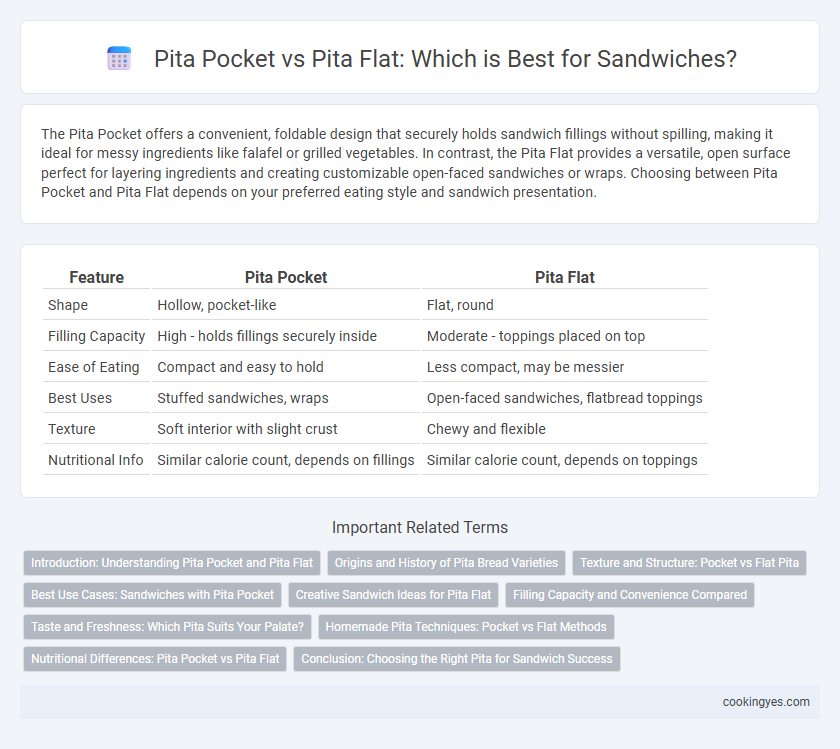The Pita Pocket offers a convenient, foldable design that securely holds sandwich fillings without spilling, making it ideal for messy ingredients like falafel or grilled vegetables. In contrast, the Pita Flat provides a versatile, open surface perfect for layering ingredients and creating customizable open-faced sandwiches or wraps. Choosing between Pita Pocket and Pita Flat depends on your preferred eating style and sandwich presentation.
Table of Comparison
| Feature | Pita Pocket | Pita Flat |
|---|---|---|
| Shape | Hollow, pocket-like | Flat, round |
| Filling Capacity | High - holds fillings securely inside | Moderate - toppings placed on top |
| Ease of Eating | Compact and easy to hold | Less compact, may be messier |
| Best Uses | Stuffed sandwiches, wraps | Open-faced sandwiches, flatbread toppings |
| Texture | Soft interior with slight crust | Chewy and flexible |
| Nutritional Info | Similar calorie count, depends on fillings | Similar calorie count, depends on toppings |
Introduction: Understanding Pita Pocket and Pita Flat
Pita Pocket is a hollow, pocketed bread ideal for stuffing with various sandwich fillings, offering convenience and portion control. Pita Flat, on the other hand, is a single flatbread without a pocket, often used for open-faced sandwiches or wraps. Both varieties provide versatile options for sandwich preparation, with differences in texture and filling capacity.
Origins and History of Pita Bread Varieties
Pita bread, with origins tracing back to ancient Middle Eastern civilizations, showcases two prominent varieties: Pita Pocket and Pita Flat. Pita Pocket evolved to create a unique pocket by baking at high temperatures, causing the dough to puff and form an internal space ideal for stuffing, a method prevalent in Levantine and Mediterranean cuisines. Meanwhile, Pita Flat, a thinner and pliable form without a pocket, has been traditionally used as a utensil or wrap, reflecting the bread's diverse cultural roles across different regional diets.
Texture and Structure: Pocket vs Flat Pita
Pita pocket offers a unique texture with a soft yet sturdy interior that holds sandwich fillings securely, preventing spillage and providing a convenient, handheld eating experience. In contrast, pita flat features a thinner, more flexible texture that is ideal for wraps or open-faced sandwiches, delivering a chewier bite and a crispier edge when toasted. The pocket's hollow structure creates distinct compartments for ingredients, while the flat pita's uniform surface allows for even distribution and layering of fillings.
Best Use Cases: Sandwiches with Pita Pocket
Pita pocket bread is ideal for sandwiches requiring a convenient, handheld option that easily holds fillings like falafel, grilled chicken, or fresh vegetables without spilling. Its hollow center creates a natural pocket, perfect for stuffing with multiple layers of ingredients, making it a versatile choice for customizable sandwiches. Pita flatbread, while thinner and less structured, suits wraps or open-faced sandwiches but lacks the containment benefits of pita pockets for mess-free eating.
Creative Sandwich Ideas for Pita Flat
Pita Flat offers a versatile base for creative sandwich ideas, allowing for open-faced presentations that showcase vibrant ingredients like roasted vegetables, hummus, feta cheese, and fresh herbs. Unlike Pita Pocket, which contains fillings inside a pocket, Pita Flat can be layered with colorful spreads and toppings for visually appealing and easily customizable sandwiches. This flexibility makes Pita Flat ideal for gourmet combinations such as Mediterranean-inspired falafel with tzatziki or avocado, tomato, and smoked turkey.
Filling Capacity and Convenience Compared
Pita pockets offer greater filling capacity due to their pocketed structure, allowing for more layers of ingredients to be securely held without spilling. Pita flats provide easier access to fillings and are more convenient for bite-sized sandwiches or wraps, but they may require careful folding to prevent contents from falling out. For sandwich lovers prioritizing maximum filling and mess-free enjoyment, pita pockets are the optimal choice, while pita flats suit quick, casual servings.
Taste and Freshness: Which Pita Suits Your Palate?
Pita pocket offers a convenient pocket-like structure that holds fillings securely, enhancing taste with a balanced blend of soft interior and slightly crisp crust that maintains freshness. Pita flat provides a versatile base with a chewier texture and thicker bite, preserving freshness longer and allowing for diverse sandwich creations. Choosing between pita pocket and pita flat depends on preference for either a handheld, mess-free experience or a hearty, fresh-tasting wrap that complements varied ingredients.
Homemade Pita Techniques: Pocket vs Flat Methods
Homemade pita pocket sandwiches require dough rolled into thicker rounds that puff up during baking, creating a hollow interior ideal for stuffing with ingredients. In contrast, pita flatbread is rolled thinner and baked to remain flat and pliable, perfect for wrapping or layering without creating a cavity. Mastering dough hydration and oven temperature ensures the desired pocket or flat texture for versatile homemade pita sandwiches.
Nutritional Differences: Pita Pocket vs Pita Flat
Pita Pocket sandwiches typically contain more calories and carbohydrates due to their larger size and pocket structure that holds extra fillings, providing a more substantial meal option. Pita Flat offers fewer calories and lower carbohydrate content, making it a lighter alternative ideal for calorie-conscious individuals or simpler sandwich preparations. Both types are rich in fiber and protein but Pita Pocket's added volume can increase sodium and fat intake depending on the fillings used.
Conclusion: Choosing the Right Pita for Sandwich Success
Pita pockets offer a convenient, hollow structure ideal for holding various sandwich fillings without spillage, making them perfect for stuffed sandwiches like falafel or gyro. Pita flats provide a versatile, foldable alternative that works well for open-faced sandwiches or wraps, allowing for more control over ingredient distribution and texture balance. Selecting the right pita depends on the desired sandwich style, with pockets suited for contained fillings and flats favored for flexible, handheld options.
Pita Pocket vs Pita Flat for Sandwiches Infographic

 cookingyes.com
cookingyes.com